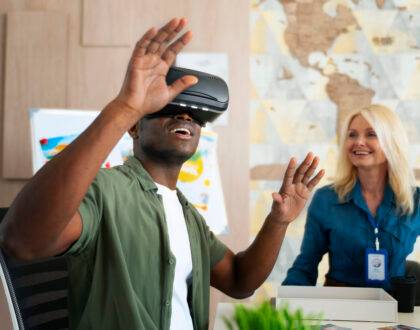Tech and Accessibility: Innovations for Inclusivity

by Web Digital
In the ever-evolving landscape of technology, the quest for innovation goes hand in hand with a commitment to inclusivity. This article explores the intersection of tech and accessibility. Showcasing how innovations are breaking barriers and creating a more inclusive digital world for individuals with diverse abilities.
The Importance of Accessibility in Tech
Accessibility in technology is about ensuring that digital platforms, devices, and services are designed to be usable by people of all abilities. It goes beyond compliance with standards; it’s a commitment to creating an inclusive environment where everyone, regardless of physical or cognitive abilities, can fully participate in the digital age.
Assistive Technologies: Empowering Individuals
Screen readers, voice recognition software, and braille displays are just a few examples of tools that enable people with visual impairments to navigate digital content. These technologies break down barriers, providing access to information and communication channels previously inaccessible.
Inclusive Design Principles
Inclusive design is a fundamental approach that seeks to create products and environments accessible to as many people as possible, regardless of their abilities. By considering diverse needs during the design phase, developers can proactively address accessibility challenges, ensuring that their creations are inherently inclusive.
Speech-to-Text and Text-to-Speech Technologies
Speech-to-text and text-to-speech technologies have transformed communication for individuals with hearing impairments or speech difficulties. These technologies enable real-time translation between spoken and written language, facilitating seamless interaction in various contexts, from virtual meetings to educational settings.
Gesture and Motion Control
Gesture and motion control technologies have opened new possibilities for individuals with mobility challenges. These interfaces allow users to interact with devices through gestures or body movements, offering an alternative to traditional input methods. This innovation empowers individuals who may have difficulty using conventional interfaces.
Haptic Feedback and Tactile Interfaces
Haptic feedback and tactile interfaces enhance the user experience by providing touch-based feedback. For individuals with visual impairments, tactile interfaces convey information through touch, offering a more immersive and inclusive interaction with digital content. This technology is particularly valuable in gaming, navigation apps, and educational tools.
Virtual Reality (VR) for Sensory Immersion
Virtual Reality (VR) is not only a form of entertainment but also a powerful tool for creating inclusive experiences. VR applications can simulate environments to provide users with diverse sensory experiences. This is especially beneficial for individuals with sensory processing disorders, allowing them to navigate and understand various scenarios in a controlled and comfortable virtual space.
Artificial Intelligence (AI) for Personalized Accessibility
AI is playing a pivotal role in personalizing accessibility solutions. Machine learning algorithms can adapt to individual needs, learning from user interactions to provide tailored assistance. From predictive text suggestions to customized voice commands, AI-driven accessibility features are advancing the concept of personalized and adaptive technology.
Bringing Accessibility to the Web
The web is a vital part of modern life, and ensuring web accessibility is a key aspect of inclusivity. Web Content Accessibility Guidelines (WCAG) set standards for web developers, emphasizing the creation of content that is perceivable, operable, and understandable for all users. Implementing these guidelines ensures that websites are accessible to individuals with diverse abilities.
Challenges and Future Considerations
While significant progress has been made, challenges persist in achieving universal accessibility. Issues such as affordability, awareness, and the need for ongoing education in the tech industry remain. The future of tech and accessibility requires a continued commitment to innovation, collaboration, and the incorporation of diverse perspectives to address the evolving needs of users.
Conclusion
Tech and accessibility are inseparable components of a digital landscape that aspires to be truly inclusive. From assistive technologies to inclusive design principles, innovations are continually expanding the possibilities for individuals with diverse abilities. As we navigate the ever-changing realm of technology, it is crucial to prioritize inclusivity, recognizing that the true measure of technological progress lies in its ability to create a world where everyone, regardless of ability, can participate fully in the digital age.
Recommended Posts

Exploring the Transformative Influence of Technology in Sports
December 5, 2023

The Evolution of AI in Education
December 4, 2023

